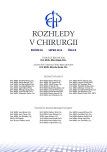-
Medical journals
- Career
The role of rotational thromboelastometry (ROTEM) in the perioperative period in a warfarinized patient (case report)
Authors: M. Durila 1; J. Schützner 2; T. Vymazal 1
Authors‘ workplace: Klinika anesteziologie, resuscitace a intenzivní medicíny, 2. LF Univerzity Karlovy a FN Motol, Praha, přednosta: MUDr. T. Vymazal, Ph. D., MHA 1; III. Chirurgická klinika 1. LF Univerzity Karlovy a FN Motol, Praha, přednosta: Prof. MUDr. R. Lischke, PhD 2
Published in: Rozhl. Chir., 2016, roč. 95, č. 8, s. 329-332.
Category: Case Report
Overview
Warfarin overdose with unmeasurable values of the prothrombin time (PT-INR) is a significant problem in the preoperative preparation of the patient for acute invasive surgery. In contrast to conventional blood clotting assays, rotational thromboelastometry (ROTEM) evaluates the coagulation profile of the whole blood and provides a more complex view of the coagulation status of the patient. Thromboelastometry results are available within about 10 minutes and help us to provide targeted ”bedside” therapy of coagulopathy in a bleeding patient. In our case report we describe a case of a patient with warfarin overdose and unmeasurable PT-INR values. The patient was indicated for urgent gastroscopy because of haematemesis and abdominal surgery because of ileus. Haematemesis was stopped by ROTEM targeted treatment of coagulopathy and the operation was performed without bleeding complications with normal ROTEM despite the prolongation of PT-INR to 1.8. Finally, we would like to say that ROTEM method can be used for rapid management of warfarin-induced coagulopathy and that surgery may be performed safely without any correction of PT-INR in case of normal ROTEM.
Key words:
prothrombin time – bleeding – surgery − thromboelastometry (ROTEM) − warfarin
Sources
1. Kessler P. Jak připravit pacienta léčeného warfarinem k operaci? Interní Med 2012;14 : 173–6.
2. Milling TJ Jr, Refaai MA, Goldstein JN, et al. Thromboembolic events after vitamin K antagonist reversal with 4-factor prothrombin complex concentrate: Exploratory analyses of two randomized, plasma-controlled studies. Ann Emerg Med 2016;67 : 96−105.
3. Kozek-Langenecker SA, Afshari A, Albaladejo P, et al. Management of severe perioperative bleeding: Guidelines from the European Society of Anaesthesiology. Eur J Anaesthesiol 2013;30 : 270−382.
4. Durila M, Malošek M. Rotational thromboelastometry along with thromboelastography plays a critical role in the management of traumatic bleeding. Am J Emerg Med 2014;32 : 288.
5. Spahn DR, Bouillon B, Cerny V, et al. Management of bleeding and coagulopathy following major trauma: an updated European guideline. Crit Care 2013;17:R76.
6. Haas T, Spielmann N, Mauch J, et al. Comparison of thromboelastometry (ROTEM®) with standard plasmatic coagulation testing in paediatric surgery. Br J Anaesth 2012;108 : 36−41.
7. Ševčík P. Intenzivní medicína. 3. přeprac. a rozš. vyd. Praha, Galén 2014 : 197−202.
8. De Pietri L, Bianchini M, Montalti R, et al. Thrombelastography-guided blood product use before invasive procedures in cirrhosis with severe coagulopathy: A randomized, controlled trial. Hepatology 2016;63 : 566−73.
9. Spiezia L, Bertini D, Salmaso L, et al. Whole blood rotation thrombelastometry in subjects undergoing vitamin K antagonist treatment: hypo - or hypercoagulable profiles? Thromb Res 2008;122 : 568−9.
Labels
Surgery Orthopaedics Trauma surgery
Article was published inPerspectives in Surgery

2016 Issue 8-
All articles in this issue
- Surgical approaches to pineal region – review article
- Treatment of acute appendicitis: Retrospective analysis
- Supravesical hernia as a rare cause of inguinal herniation and its laparoscopic treatment with TAPP approach
- Free-floating thrombus in the internal carotid artery treated by anticoagulation and delayed carotid endarterectomy
- The role of rotational thromboelastometry (ROTEM) in the perioperative period in a warfarinized patient (case report)
- Perforation of the right ventricle of the heart as a complication of CT guided percutaneous drainage of a subphrenic abscess – a case report
- Deceased donor uterus retrieval – The first Czech experience
- Perspectives in Surgery
- Journal archive
- Current issue
- Online only
- About the journal
Most read in this issue- Surgical approaches to pineal region – review article
- Treatment of acute appendicitis: Retrospective analysis
- Free-floating thrombus in the internal carotid artery treated by anticoagulation and delayed carotid endarterectomy
- Supravesical hernia as a rare cause of inguinal herniation and its laparoscopic treatment with TAPP approach
Login#ADS_BOTTOM_SCRIPTS#Forgotten passwordEnter the email address that you registered with. We will send you instructions on how to set a new password.
- Career

